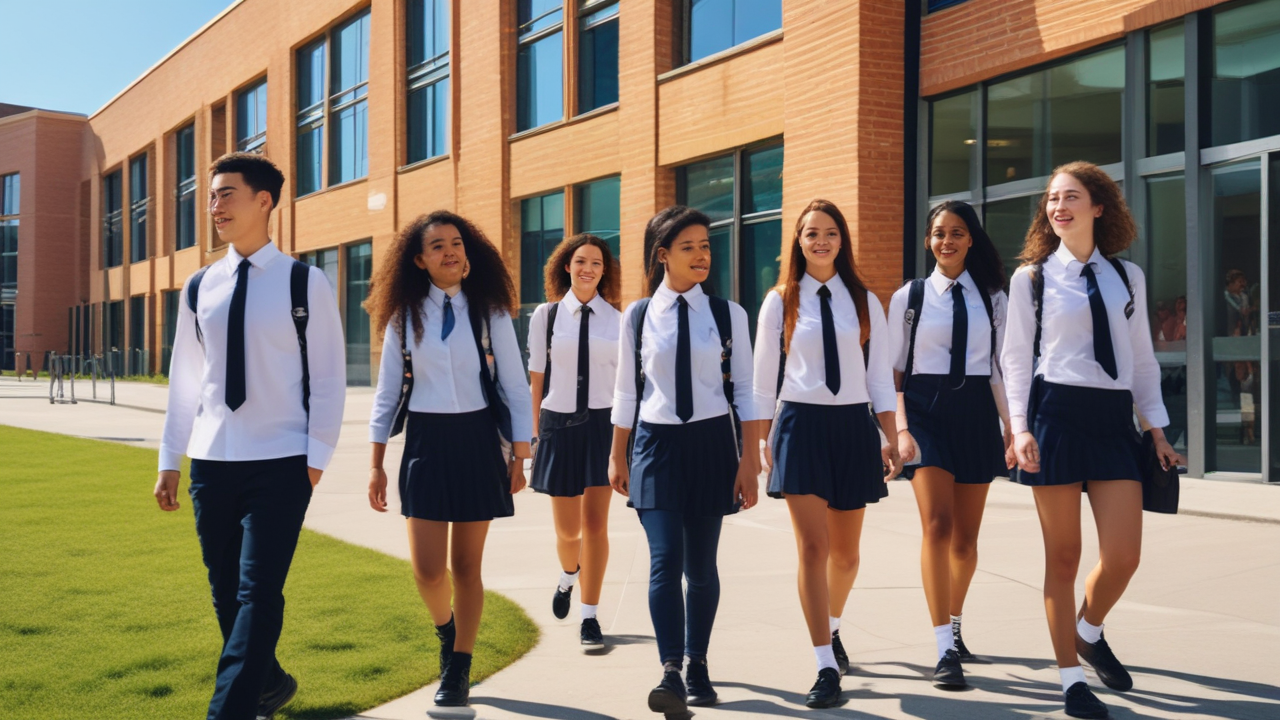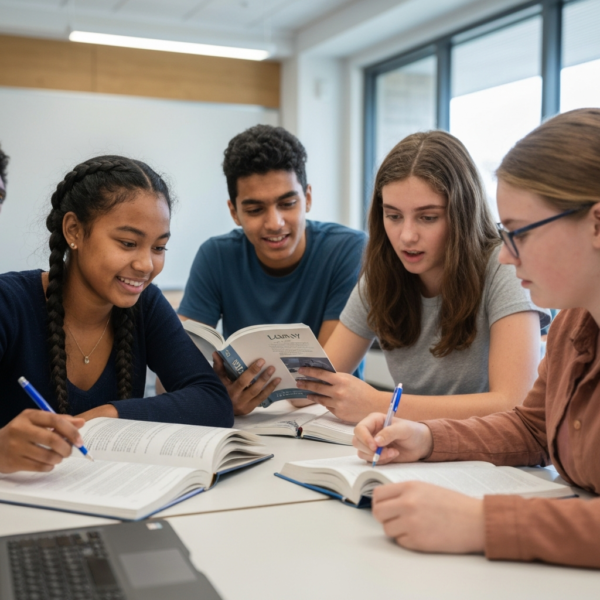Key Highlights: What Is Secondary Education
- Secondary education helps kids move from elementary school to higher education. It usually covers the years spent in high school or secondary school.
- Around the world, secondary education is split into lower secondary (junior high) and upper secondary (senior high). Each stage comes with its own grade levels and course plans.
- The goal of secondary schooling is to build a strong knowledge base. It also helps students learn about human rights and gives some vocational training that can help them in many career paths.
- Secondary schools and independent schools teach a wide range of classes. These include natural sciences, foreign languages, and physical education. This setup helps students get ready for many kinds of new chances.
- Primary and secondary education are different in a few ways. These differences are in the depth of topics, the teaching methods used, and the way each part fits into the education system as a whole.
- The way secondary education is set up and how long it lasts changes from place to place. For example, the united states, united kingdom, india, and canada each have their own ways of doing things.
Introduction
Secondary education comes after primary education. It is a big part of the formal education system. Students at this level can be many ages. So, what is secondary education? It helps get them ready for higher education, job training, or work. Every country handles secondary education in its own way. But, one thing is the same everywhere. This stage helps students move from the basics they learn in primary education to the deeper study found in higher education. Because of this, secondary education is a must in the academic journey of all students.
What Is Secondary Education?
Secondary education, often known as senior high school education, follows primary education and precedes higher education. Typically, students aged 11 to 18 attend secondary school, which varies in structure worldwide. The primary focus shifts from basic skills in elementary school to more complex subjects in secondary education, fostering critical thinking and practical skills. This stage serves as a bridge to specialized training or degree programs in higher education. Thus, secondary schooling connects foundational learning with advanced study paths.
At institutions like USCA Academy’s Private School in Mississauga, students are introduced to core and elective subjects that prepare them for university admissions worldwide.
Levels of Secondary Education
Secondary education usually has two main parts: lower secondary and upper secondary. The levels of secondary education help students learn more about new topics and get important life skills as they grow up. Lower secondary, which people sometimes call junior secondary or junior high school, is made for younger teens. It helps them understand the basics of different subjects.
Upper secondary has other names too, like senior secondary or high school, and preparatory school. At this level, students get ready to either go to higher education or start working. Each level in the school system fits the needs of students at different ages. The levels also make sure students are ready for what comes next in learning.
Lower (junior) secondary
In many places, lower secondary is the stage when students move from primary school into secondary school. This part of secondary education is often called junior secondary. It usually includes students who are about 11 to 15 years old. This step helps get students ready for more focused learning in the future. The things students study can change from one school to another. Many students will learn maths, natural sciences, and foreign languages at this time so they can build a good set of skills.
In the United States, the United Kingdom, and some other places, lower secondary is something all students must do. This time in school is very important. It helps decide the path that students will take next. They might go on to vocational schools for vocational training after this, or they may move up to upper secondary school to keep learning more in secondary education.
Upper (senior) secondary
Upper secondary education is for students who are about 15 to 18 years old. This is a big change in the education system. At this stage, students can go to a comprehensive high school, a vocational high school, or a special school, which are all examples of types of schools. These places help students get ready for further education or for work.
The courses in upper secondary often include subjects like natural sciences and foreign languages. High school students learn these important things to help them later. There is a strong focus on higher education, with high standards in the lessons. This helps students get into degree programs at a university or start vocational training. With this, students have many career paths and can also grow as people.
Purpose and Objectives of Secondary Education
The purpose of secondary education, as the role of secondary education highlights, is to give students the basic skills and knowledge they need to do well in life and at work. This part of the education system builds on what students learn in primary education. It helps them go past just knowing how to read and do math. Students learn to think on their own, make choices, and look at things in new ways.
Secondary education has many jobs in the modern education system. It helps teach students about human rights. It also helps students learn how to get along with other people and often offers them vocational training for career paths they may choose. This stage connects primary education with further education. It gets students ready for university, technical school, or work if that is what they want. Learning here also shows the value of good citizenship, working with others, and never stopping learning.
In some places, secondary education is a right and free education enables students to go through it for a set number of years. This allows all young people to get chances for both personal and work growth. It opens doors for what they can do next in life.
Benefits of Secondary Education

Secondary education gives students many important benefits. It is the base for future learning and jobs. In these years, students see many teaching methods and different subjects. Because of this, they learn how to think well, solve problems, and use skills in real life.
Key benefits include:
- Laying the groundwork for further education and special training.
- Helping people get jobs and grow their careers by learning many skills.
- Building social and emotional growth through work with others and sharing ideas.
- Giving students the chance to try new things and see what skills or interests they have.
The importance of secondary education can be seen in how it helps students get ready for our world, which is always changing. This type of learning does more than help you with tests. It helps you face and solve problems in your daily life. As Nelson Mandela said, “Education is the most powerful weapon which you can use to change the world.” Secondary schooling helps set up students for a good life and future achievements.
What Age and Grades Fall Under Secondary Education?
Globally, the age range and grade levels for secondary schooling can differ, but most systems start secondary education between ages 11 and 13 and what age is secondary education finish between ages 16 and 18. Grades or year levels under secondary education usually cover 6th or 7th grade through 12th grade, with slight variations by country.
Below is a detailed comparison across select countries:
Country | Age Range | Grades/Years Covered | Typical School Names |
|---|---|---|---|
United States | 12-18 | 6-12 (Middle & High) | Middle School, High School |
Canada | 12-18 | 7-12 or 8-12 | Junior High, High School |
United Kingdom | 11-18 | Year 7-13 | Secondary School, Sixth Form |
India | 14-18 | 9-12 | Secondary, Senior Secondary |
Australia | 12-18 | Year 7-12 | Secondary College, High School |
Understanding your local school system’s structure helps clarify when students typically experience secondary education.
Core Curriculum in Secondary Education
The secondary school curriculum gives students a wide range of academic and hands-on subjects. In lower secondary, students work on main subjects like math, language arts, natural sciences, and social studies, akin to those taught in a grammar school. This strong start helps make sure all students reach basic learning goals before they pick other subjects.
In upper secondary, students can pick elective classes based on what they like and the career paths they want. Some options are advanced natural sciences, foreign languages, technology classes, vocational programs, and physical education. In the United States, the high school curriculum must include English, math, science, and social studies. But students also get to choose from electives like art, computer science, or business. These curriculum choices help with college readiness and vocational skill-building. This way, secondary education can meet the different needs of all students.
For international students looking to complete their high school in Canada, USCA Academy offers Grade 9–12 programs aligned with the Ontario curriculum.
Difference Between Primary and Secondary Education
The difference between primary and secondary education is in both what students learn and how teachers work with them. Primary education, also called elementary education, helps kids start with reading, writing, math, and simple ideas about people and the world. Teachers use generalist teaching methods at this stage. The main aim here is to build a good base in reading, math, and skills people need in life.
Secondary education, which includes junior secondary, is more focused on certain subjects. At this level, students take different classes in science, the humanities, arts, and job-related subjects. There are often different teachers for each subject, and the way of teaching is more specialized. While primary education looks at a wide range of basic skills, secondary education especially high school and upper secondary—helps students learn to think more deeply. Students are asked to work on their own more and to get ready for higher education or to start a job soon after school ends. In many places, the word “high school” means upper secondary school, which is the last stage before someone can go to tertiary education or begin working.
Examples of Secondary Education Around the World
Secondary education meaning globally varies significantly across the globe, yet it also shares commonalities. For instance, in the United States and Canada, secondary education typically encompasses high school, which includes grades 9 through 12. This structure ensures students receive a comprehensive education before graduation.
In the United Kingdom, secondary education qualifications are divided into two distinct phases: lower secondary and upper secondary. The upper secondary phase culminates in A-levels or equivalent qualifications, which are crucial for university entrance and further education.
Similarly, in India, the secondary education system is structured into two parts. The first phase includes grades 9 and 10, known as secondary schooling, followed by higher secondary school education, which covers grades 11 and 12. During this latter phase, students have the option to focus on subjects that prepare them for college or vocational training for various careers.
These examples illustrate how secondary education systems adapt to reflect the cultural and regional contexts of their respective countries. However, they also maintain essential objectives and principles that are consistent across different educational landscapes.
US, UK, India, Canada
Secondary education looks different in every country, and each has its own focus and structure in the education system:
- United States: Middle school or junior high covers grades 6 to 8, and high school is grades 9 to 12. The curriculum is broad, and there are many electives to choose from.
- United Kingdom: Lower secondary goes from Years 7 to 11. Upper secondary, also called sixth form, includes Years 12 and 13. Students take GCSEs and then go on to A-levels or get vocational qualifications.
- Canada: There is junior high for grades 7 to 9, or sometimes grades 8 to 10. High school is usually from grades 10 to 12 or grades 9 to 12. Students take either an academic or applied track.
- India: Secondary runs from grades 9 to 10, and higher secondary or senior secondary includes grades 11 to 12. After grade 10, students can choose streams like science, commerce, or arts.
Every country sets up its secondary schooling and high school system to fit the International Standard Classification of Education. Yet, the actual curriculum, school boards, and how things are run depend on what the people in that country value and want. For example, in Canada, provincial school boards manage the education system. In the United Kingdom, sixth form helps people get ready for university or a job. This shows how secondary education, junior high, lower secondary,
Why Secondary Education Matters Today
The importance of secondary education is key in today’s world. In many places, it is a type of compulsory education. This means all students must go, and it gives them the knowledge and skills they need for both further education and many different career paths. In secondary education, students get used to new technology, work with others, and learn how to think in smart ways. These things are very important now because the world is always changing fast.
Yet, there are still some problems. Students and teachers can deal with things like not having the same amount of help or tools everywhere, learning new teaching methods, and working hard to keep up with all the studies. To fix these, there are special steps taken, better teacher training in special education, and the use of technology to make learning better. In the end, secondary education builds a good base for every person’s own growth and for work life, too. This helps with lifelong learning and also gives a big push to making our society better and stronger.
Conclusion
To sum up, secondary education is important for every student in the world. This stage of education provides you with the key facts and skills you need. It also gets you ready for college and future jobs. If you know about the different goals, levels, and classes in secondary education, it can help you and your family make smart choices about your next steps. As you go through this key time, you should think about how the lessons you learn will help you grow both in life and work. If you want to learn more about your school options, reach out to USCA Academy for a free talk to find out which secondary education path is right for you.
Frequently Asked Questions About What Is Secondary Education
1. Is secondary education the same as high school in Canada?
In Canadian education, secondary schooling has both junior high and public schools high school. High school is the name for the last years, which are grades 9 to 12. Both junior high and high school are a part of secondary education in the Canadian school system.
2. What are the main differences between secondary and post-secondary education?
Secondary education is taught in secondary schools or comprehensive schools. It covers basic subjects that all students need to learn. After finishing this, what comes after secondary education is post-secondary education, also known as tertiary education, which starts. In this stage, people go to colleges, universities, or technical schools. Here, they study more about a special subject. This helps them get a degree or a professional certificate. This is the path people take after secondary education.
3. Can you skip secondary education?
In many countries, secondary education is part of formal schooling and is compulsory education. People are not allowed to skip this step in state schools, as it connects primary education with higher education. Only in rare cases, and with special reasons or official approval, someone may be allowed to skip it.
4. What skills are developed in secondary education?
Secondary education helps students learn many skills through different teaching methods. It gives them chances to build critical thinking, good communication, problem-solving, teamwork, and learn vocational training. These skills help students get ready for higher education, go into the workforce, and take part in the world around them. That is why this stage in the school system is so important and useful for all.







